Land Invertebrates
Media
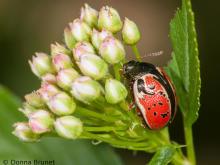
Species Types
Scientific Name
Calligrapha spiraea
Description
The ninebark calligraphy beetle is one of nearly 40 North American calligraphy beetles, named for the scrawly markings on their backs. Most calligraphy beetles require particular host plants.
Media
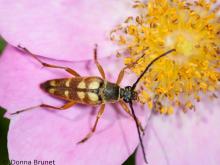
Species Types
Scientific Name
Typocerus velutinus
Description
The banded longhorn is a common species of longhorned beetle. Adults visit flowers for nectar, and larvae feed on decaying oak and hickory wood.
Media
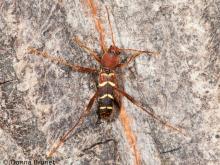
Species Types
Scientific Name
Neoclytus acuminatus
Description
Red-headed ash borers resemble wasps, but they are harmless to people. The colors and markings are distinctive. Their larvae feed on a variety of dead or dying hardwoods, helping the decomposition process and enriching the soil.
Media

Species Types
Scientific Name
Saperda tridentata
Description
The elm borer is a longhorned beetle whose larvae bore galleries under the bark of elm trees. The orangish markings on the adults are distinctive.
Media

Species Types
Scientific Name
Tachypompilus ferrugineus
Description
The rusty spider wasp hunts wolf spiders, usually in open areas. Females create nests in rock piles or in cracks in rock walls or foundation stones. Adults are often seen taking nectar from flowers.
Media

Species Types
Scientific Name
Poecilopompilus algidus and P. interruptus
Description
Poecilopompilus spider wasps provision their nests with orbweaver spiders. They dig nest burrows into the ground and therefore prefer sandy or other workable substrates.
Media

Species Types
Scientific Name
Entypus aratus, E. unifasciatus, E. fulvicornis, and others
Description
Spider wasps in genus Entypus are bluish black and usually have some amount of amber color on their dark, smoky wings. Some species have bright yellow antennae.
Media
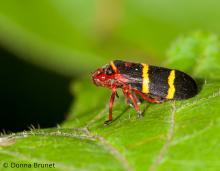
Species Types
Scientific Name
Prosapia bicincta
Description
The two-lined spittlebug is a common member of the froghopper family. The two lines may be red, orange, or yellow. Some individuals are all black, except for the red eyes.
Media
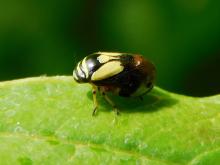
Species Types
Scientific Name
Clastoptera proteus
Description
The adult dogwood spittlebug has distinctive black and yellow markings. It feeds on dogwoods, blueberries, and their relatives.
Media

Species Types
Scientific Name
Neoscona crucifera
Description
A widespread species, the barn spider commonly builds its webs in woods and on the eaves of barns, houses, and similar structures.
See Also



Media

Species Types
Scientific Name
Cisseps fulvicollis
Description
The yellow-collared scape moth is more often “orange-collared.” And whether you think it looks more like a firefly or a wasp, it’s still a moth!
Media

Species Types
Scientific Name
Nearly 150 species in North America north of Mexico
Description
Slim, delicate plume moths are instantly recognizable by their T-shaped silhouette, long legs, and muted shades of tan and brown. It can be hard to separate the various species.
Media

Species Types
Scientific Name
Pyrrharctia isabella
Description
Not many people know the adult Isabella tiger moth when they see one, but we’re all acquainted with its caterpillar, the woolly worm, or woolly bear.
About Land Invertebrates in Missouri
Invertebrates are animals without backbones, including earthworms, slugs, snails, and arthropods. Arthropods—invertebrates with “jointed legs” — are a group of invertebrates that includes crayfish, shrimp, millipedes, centipedes, mites, spiders, and insects. There may be as many as 10 million species of insects alive on earth today, and they probably constitute more than 90 percent all animal species.





















